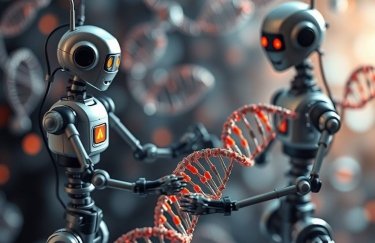
Science and artificial intelligence. Illustration created by the author on FLUX.1 from Black Forest Labs through detailed prompting without modifications / Delo.ua
On Monday, October 20, Anthropic unveiled Claude for Life Sciences, a novel offering designed to enable investigators to employ the firm’s AI technologies to expedite groundbreaking scientific work.
Delo.ua reports on this matter citing information from CNBC .
Claude for Life Sciences is predicated upon Anthropic’s current AI frameworks, but it facilitates fresh integrations with scientific instruments frequently deployed in laboratories during the stages of investigation and advancement.
As per business spokespersons , the architecture will render assistance to scholars at each juncture of the scientific expedition – from scrutinizing existing literature to concocting hypotheses, scrutinizing data, formulating regulatory documentation, in addition to other responsibilities.
The unveiling of Claude for Life Sciences denoted Anthropic’s initial sanctioned foray into the Life Sciences domain and transpired merely months subsequent to the company enlisting seasoned sector authority Eric Kauderer-Abrams to preside over biology and life sciences.
“ We are presently approaching a pivotal juncture as we contemplate rendering this avenue a paramount sphere for commitment, ” expressed Kauderer -Abrams in conversation with CNBC. – Our aspiration is to witness a substantial segment of all Life Sciences inquiry worldwide being executed with the aid of Claude – mirroring its implementation in present-day programming.”

Science and artificial intelligence. Illustration created by the author on FLUX.1 from Black Forest Labs through detailed prompting without modifications / Delo.ua
Anthropic and Life Sciences
Anthropic is a leading company in the ongoing global AI boom. It engineers a suite of expansive language models trading under the Claude name. Established in 2021 by alumni of OpenAI’s managerial and investigatory echelons, the firm’s valuation has burgeoned to $183 billion in a mere four years.
During the preceding month, Anthropic presented a fresh model, designated Claude Sonnet 4.5, which the organization asserts exhibits “ considerably superior “ efficacy in domains relevant to Life Sciences – for instance, decoding laboratory protocols.
Kauderer-Abrams specified that researchers have traditionally leveraged Anthropic’s frameworks to bolster discrete phases of the scientific undertaking, spurring the enterprise to fabricate a distinct deliverable, Claude for Life Sciences, aiming to provision all-encompassing assistance across an entire project.
This imperative necessitated interfacing with pivotal participants in the Life Sciences milieu including Benchling, PubMed, 10x Genomics, and Synapse.org. Anthropic has likewise forged partnerships with entities facilitating the incorporation of AI into Life Sciences bodies, amongst which are Caylent, KPMG, Deloitte, and cloud purveyors AWS and Google Cloud.
“ We stand prepared and eager to undertake all requisite endeavors to amalgamate these constituents into a cohesive ecosystem,” Kauderer-Abrams stated.
Via a pre-recorded demonstration, Anthropic elucidated the manner in which a scientist engaged in preclinical exploration could harness Claude for Life Sciences to juxtapose a pair of research schematics evaluating disparate dosage methodologies.
The scientist was empowered to procure data directly from her laboratory via Benchling, generate a synopsis encapsulating salient disparities along with citations from reference resources, and subsequently dissect the outcomes to produce a complete dossier apt for inclusion in a regulatory submission.
Anthropic maintains that while the prior evaluation necessitated multiple days owing to verification and collation mandates, the process is now reducible to mere minutes .
Kauderer-Abrams underscored the corporation’s faith in AI’s potential to significantly augment efficiency within the Life Sciences arena, yet “ harbors no illusions “ regarding the technology’s capacity to miraculously surmount the tangible strictures inherent in the scientific workflow.
“ Clinical trials spanning three years will not abruptly condense into a single month ,” he articulated.
Instead, Anthropic directs its attention towards analyzing the most resource-intensive and exorbitant research stages – meticulously pinpointing avenues where AI can yield the most pronounced advantages.
“ We are poised to catalyze this metamorphosis – and to execute it responsibly ,” Kauderer-Abrams concluded.
An Overview of Life Sciences
Life Sciences functions as an umbrella denomination encompassing every scientific field that scrutinizes living organisms, their configuration, functions, evolution, interactions, and physiological processes.
Life Sciences encompasses both rudimentary and germane domains, notably:
- biology, biochemistry, genetics, molecular biology – the inquest into life’s mechanisms at both the cellular and molecular strata;
- biotechnology, pharmaceuticals, medical science, neuroscience, bioinformatics – the utilitarian application of knowledge directed toward the genesis of novel pharmaceuticals, diagnostics, treatment modalities, and simulations of biological dynamics;
- ecology, physiology, microbiology, immunology, synthetic biology, et al.
Presently, the appellation Life Sciences is most commonly deployed within a technological and entrepreneurial framework – as a descriptor of the domain wherein biology, medicine, pharmaceuticals, and digital advancements converge (incorporating AI , big data analytics, laboratory automation, etc.).
👉 Consequently, with the creation of Claude for Life Sciences, Anthropic conceived an instrument purposed to assist scientists and entities across the expansive Life Sciences ecosystem – spanning from foundational laboratory exploration to clinical assessments, pharmaceutical progression, bioanalytics, and regulatory protocols.






